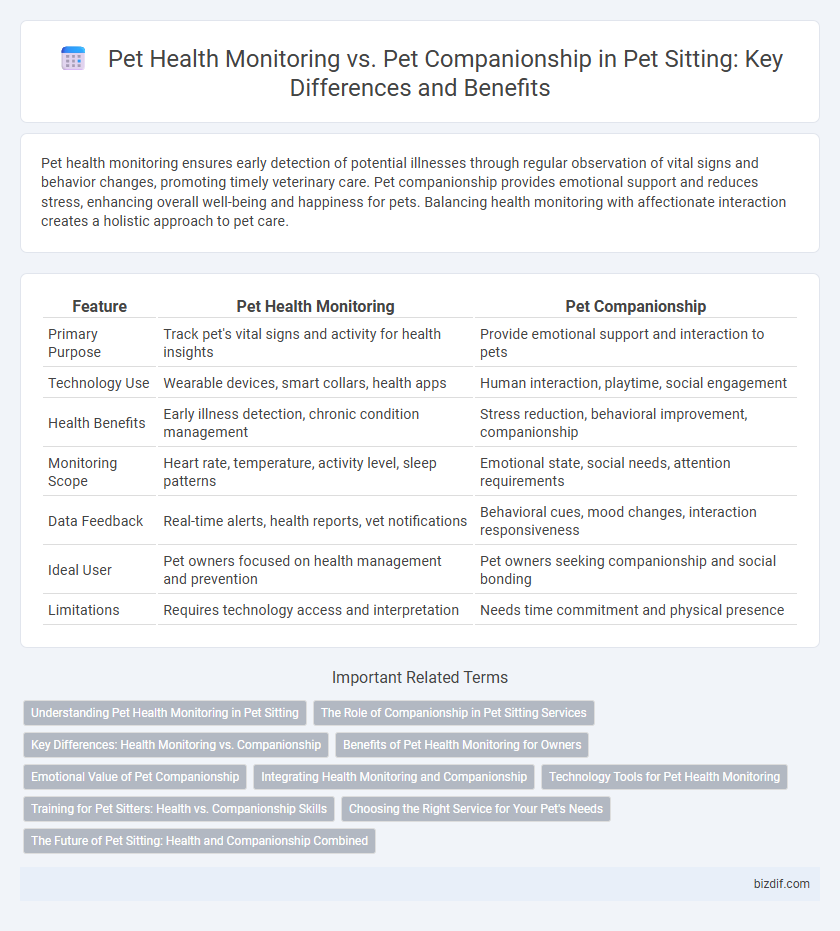Pet health monitoring ensures early detection of potential illnesses through regular observation of vital signs and behavior changes, promoting timely veterinary care. Pet companionship provides emotional support and reduces stress, enhancing overall well-being and happiness for pets. Balancing health monitoring with affectionate interaction creates a holistic approach to pet care.
Table of Comparison
| Feature | Pet Health Monitoring | Pet Companionship |
|---|---|---|
| Primary Purpose | Track pet's vital signs and activity for health insights | Provide emotional support and interaction to pets |
| Technology Use | Wearable devices, smart collars, health apps | Human interaction, playtime, social engagement |
| Health Benefits | Early illness detection, chronic condition management | Stress reduction, behavioral improvement, companionship |
| Monitoring Scope | Heart rate, temperature, activity level, sleep patterns | Emotional state, social needs, attention requirements |
| Data Feedback | Real-time alerts, health reports, vet notifications | Behavioral cues, mood changes, interaction responsiveness |
| Ideal User | Pet owners focused on health management and prevention | Pet owners seeking companionship and social bonding |
| Limitations | Requires technology access and interpretation | Needs time commitment and physical presence |
Understanding Pet Health Monitoring in Pet Sitting
Pet health monitoring in pet sitting involves continuous observation of vital signs, behavior, and nutritional intake to detect early signs of illness or distress. Advanced tools like wearable health trackers and regular vet updates enhance accuracy, ensuring pets receive timely care. This focus on health monitoring complements pet companionship by proactively addressing well-being beyond emotional support.
The Role of Companionship in Pet Sitting Services
Companionship plays a crucial role in pet sitting services by providing emotional support and reducing stress for pets during owner absence. While pet health monitoring ensures physical well-being through tracking vital signs and detecting illnesses, companionship addresses behavioral needs and prevents anxiety-related conditions. Effective pet sitting balances these aspects to promote overall pet wellness and happiness.
Key Differences: Health Monitoring vs. Companionship
Pet health monitoring involves tracking vital signs, behavior patterns, and potential symptoms using devices or regular check-ins to ensure early detection of illnesses. Pet companionship emphasizes emotional support, social interaction, and reducing loneliness through presence and engagement. While health monitoring prioritizes physical well-being and preventive care, companionship focuses on mental health and bonding.
Benefits of Pet Health Monitoring for Owners
Pet health monitoring offers owners real-time insights into their pets' vital signs, activity levels, and behavioral changes, enabling early detection of potential health issues. This proactive approach reduces veterinary costs and prevents emergencies by ensuring timely medical intervention. Continuous health tracking enhances pet well-being and provides peace of mind for owners, distinguishing it from traditional pet companionship roles.
Emotional Value of Pet Companionship
Pet companionship provides essential emotional support, reducing stress and anxiety in pets through social interaction and bonding. Continuous physical presence helps monitor subtle behavioral changes often missed by remote health devices, enhancing overall wellbeing. The emotional connection built during companionship contributes significantly to a pet's mental health, promoting a balanced and happy life.
Integrating Health Monitoring and Companionship
Integrating pet health monitoring with companionship enhances overall animal well-being by combining real-time vital sign tracking with emotional support. Advanced wearables and smart collars provide continuous data on activity levels, heart rate, and sleep patterns, enabling pet sitters to detect early signs of illness. This holistic approach ensures pets receive both attentive care and affectionate interaction, promoting a balanced, healthy lifestyle.
Technology Tools for Pet Health Monitoring
Technology tools for pet health monitoring, such as wearable trackers and smart collars, provide real-time data on pets' vital signs, activity levels, and sleep patterns, enabling early detection of health issues. These devices integrate with mobile apps to offer personalized alerts and historical health records, facilitating proactive care and veterinary consultations. Enhanced pet health monitoring empowers pet sitters and owners to maintain optimal well-being while complementing traditional pet companionship.
Training for Pet Sitters: Health vs. Companionship Skills
Effective pet sitting requires specialized training that balances health monitoring skills with companionship techniques to ensure overall pet wellbeing. Pet sitters must be proficient in recognizing signs of illness, administering medication correctly, and responding to emergencies while also providing emotional support and engaging activities that ease pet anxiety. Investing in comprehensive training programs enhances a sitter's ability to deliver personalized care, combining medical vigilance with affectionate interaction.
Choosing the Right Service for Your Pet's Needs
Pet health monitoring services provide real-time data on vital signs and activity levels, crucial for pets with medical conditions requiring close observation. Pet companionship focuses on emotional well-being through social interaction, exercise, and play, ideal for pets needing mental stimulation and affection. Selecting the right service depends on your pet's specific health requirements and personality traits to ensure both physical safety and emotional happiness.
The Future of Pet Sitting: Health and Companionship Combined
Advanced pet sitting integrates health monitoring technologies and companionship to ensure comprehensive care. Real-time biometric tracking systems, such as wearable devices, enable sitters to detect early signs of illness while maintaining emotional support through interactive play and social engagement. Combining these approaches reflects the future of pet sitting, enhancing well-being and reducing stress for pets during owners' absence.
Pet health monitoring vs Pet companionship Infographic

 bizdif.com
bizdif.com